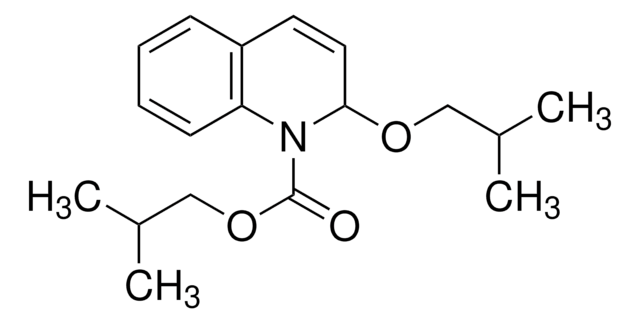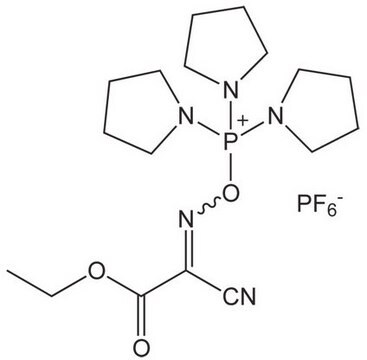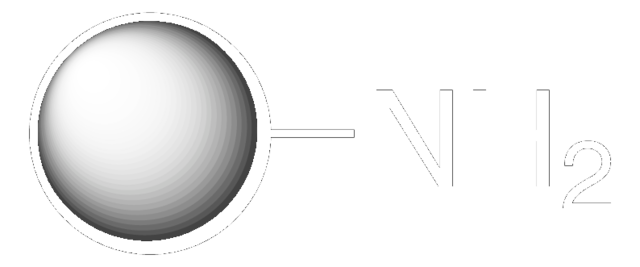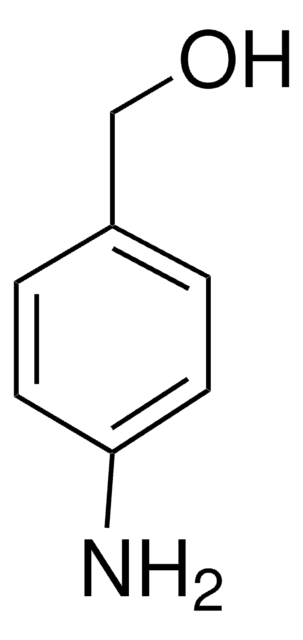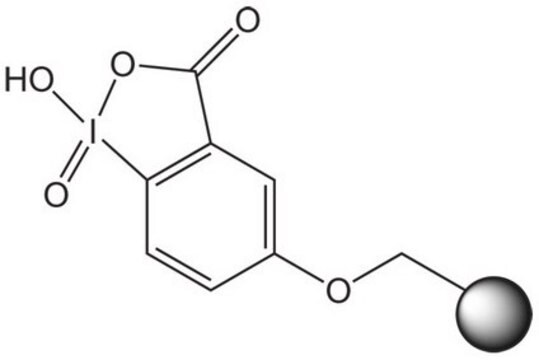8.55046
IIDQ-polystyrene
Novabiochem®
Autenticatiper visualizzare i prezzi riservati alla tua organizzazione & contrattuali
About This Item
Codice UNSPSC:
13111023
NACRES:
NA.22
Prodotti consigliati
Livello qualitativo
Nome Commerciale
Novabiochem®
Stato
beads
Impiego in reazioni chimiche
reaction type: solution phase peptide synthesis
Produttore/marchio commerciale
Novabiochem®
applicazioni
peptide synthesis
Temperatura di conservazione
2-8°C
Categorie correlate
Descrizione generale
IIDQ-polystyrene (IIDQ-PS) [1] is a polymer-supported version of the IIDQ coupling reagent [2]. IIDQ has many advantages over conventional carbodiimide- or uronium-based reagents: no preactivation step is required, and acid, amine and coupling reagent can be added in any order; in contrast to uronium-based reagents like HBTU, it cannot form guanidinium by-products; and it is totally stable to base. The treatment of a carboxylic acid with IIDQ-PS in DCM or MeCN rapidly generates in situ the corresponding isobutoxycarbonyl mixed anhydride [3]. Attack by nucleophiles preferentially takes place at the less hindered and more electrophilic carbonyl of the carboxylic acid moiety, releasing only volatile carbon dioxide and isobutanol as by-products. If reaction is carried out in the presence of an amine, amide bond formation occurs concurrently with generation of the anhydride. Alternatively, addition of NaBH4 or polymer-supported borohydride to the anhydride will lead directly to the corresponding alcohol. IIDQ-PS appears to be particularly effective for mediating the acylation for anilines, and has also been found to couple peptide fragments without epimerization. In a comparative study, IIDQ-PS was found to give higher yields and greater purities than HATU, EDC-PS or DCC-PS [4]. Occasionally, with some secondary amines the formation of isobutyl carbamate by-products has been observed, resulting from attack by the amine at the carbonyl group.
Literature references
[1] E. Valeur, et al. (2005) Chem. Commun., 1164.
[2] Y. Kiso, et al. (1973) Chem. Pharm. Bull., 21, 2507.
[3] J. R. Vaughan (1951) J. Am. Chem. Soc., 73, 3547.
[4] E. Valeur & M. Bradley, unpublished results.
Literature references
[1] E. Valeur, et al. (2005) Chem. Commun., 1164.
[2] Y. Kiso, et al. (1973) Chem. Pharm. Bull., 21, 2507.
[3] J. R. Vaughan (1951) J. Am. Chem. Soc., 73, 3547.
[4] E. Valeur & M. Bradley, unpublished results.
Linkage
Replaces: 01-64-0469
Risultati analitici
Color (visual): yellow to beige to amber
Appearance of substance (visual): beads
Loading (determined by HPLC after reaction of 3-phenylpropionic acid with cyclohexlamine): 1.3 - 1.9 mmol/g
Swelling Volume (in DMF): lot specific result
The polymer matrix is copoly (styrene-1 % DVB) 200 - 400 mesh.
Appearance of substance (visual): beads
Loading (determined by HPLC after reaction of 3-phenylpropionic acid with cyclohexlamine): 1.3 - 1.9 mmol/g
Swelling Volume (in DMF): lot specific result
The polymer matrix is copoly (styrene-1 % DVB) 200 - 400 mesh.
Note legali
Novabiochem is a registered trademark of Merck KGaA, Darmstadt, Germany
Codice della classe di stoccaggio
11 - Combustible Solids
Classe di pericolosità dell'acqua (WGK)
WGK 1
Punto d’infiammabilità (°F)
Not applicable
Punto d’infiammabilità (°C)
Not applicable
Certificati d'analisi (COA)
Cerca il Certificati d'analisi (COA) digitando il numero di lotto/batch corrispondente. I numeri di lotto o di batch sono stampati sull'etichetta dei prodotti dopo la parola ‘Lotto’ o ‘Batch’.
Possiedi già questo prodotto?
I documenti relativi ai prodotti acquistati recentemente sono disponibili nell’Archivio dei documenti.
Il team dei nostri ricercatori vanta grande esperienza in tutte le aree della ricerca quali Life Science, scienza dei materiali, sintesi chimica, cromatografia, discipline analitiche, ecc..
Contatta l'Assistenza Tecnica.

